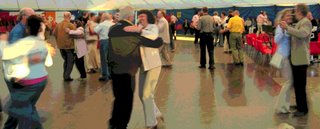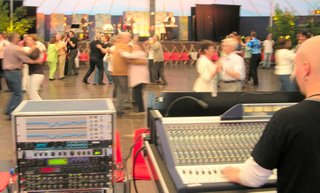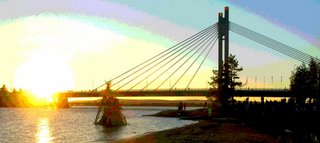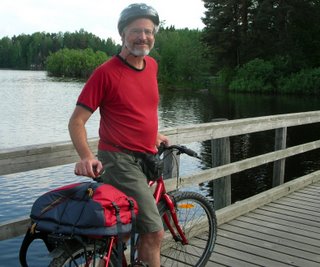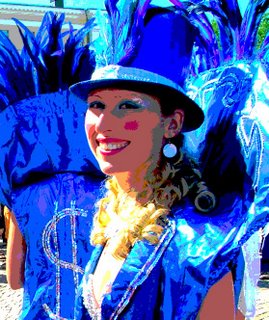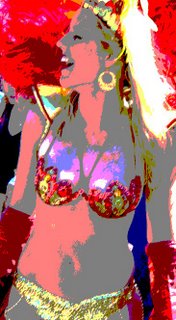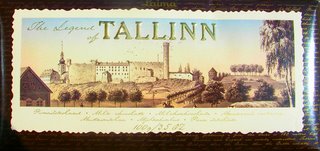
Tallinn is an 80 kilometer journey south across the Gulf of Finland from Helsinki. The trip takes less than two hours by hydrofoil.

This is a popular side trip, and is well worth it. Tallinn is famous for its well-preserved and picturesque old town, where medieval buildings are preserved from the time it was a prosperous Baltic trading center, part of the Germanic Hanseatic League. The Estonian people are related in their language to the Finns, and this makes them distinctive from their neighbors the Lithuanians and Latvians, as well as the Russians. About 30% of the population of Estonia is Russian, a legacy of more than a half century of Soviet rule that only ended in 1991. I spoke to two young men at the outdoor dining area at McDonalds (the McFish sandwich is a bargain in Tallinn at 24 kroon (about 2 US dollars). They were blond and blue-eyed computer designers for an advertising firm. One of them was ethnically Russian, and affirmed his loyalty to Estonia.

Estonian, in fact, was his first language. Both of the young men, Kuril and Lennart, expressed their enthusiasm for American culture, such as music and television programs like the Simpsons. Lennart quoted the German metal band Rammstein's song, "We're all living in Amerika." Sitting there at McDonald's at the entrance to the old town of Tallinn, I could hardly disagree.

Summer in Tallinn is warm and blue, at least this summer, and a highlight for tourists is to sit outside at one of the many dining establishments and enjoy whatever cuisine they choose--local, medieval, Indian, Russian, Texan. This is a sign at a restaurant where I had a delicious fish dish and a local beer. I sat with a young American who was reading Lermontov in Russian; he was working for Bloomberg News Services in Moscow.
Following are a sampling of some of the music posters, whose typical vocabulary reflects, like in so many European countries, the strong influence of modern music from the Americas (the US and the Latin/Caribbean world): jazz, blues, bossa nova, reggae, hip hop, funk, etc.

In Estonia as in Finland and in Sweden, the American influence is reflected in local pop and rock groups who perform their music in English. One of the aspiring popular groups in Estonia is the young female trio "Vanilla Ninja."

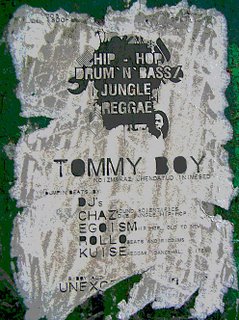



At the shopping mall near the harbor (where I bought the Tallinn Chocolate at the head of this report), many vendors sold T-shirts with musical and other pop icons,

such as Kiss, Che Guevara, and the Finnish hard rock / metal group "Lordi", who have gained recent fame as the surprise winners of the 2006 Eurovision song contest, with their "Hard rock Hallelujah."

Finally, here are two more photos, one of a nude in front of the modern Culture Keskus (Culture Center)and a panorama of Tallinn from the Harbor; one can see the Alexander Nevsky Orthodox church, from the late 19th century, on the horizon at the center right.


 Friday evening June 23rd was celebrated as midsummers solstice in Rovaniemi, the provincial capital of Finnish Lapland. It is a town of around 60,000 people, with two universities, located 6 km south of the Arctic Circle. The photo here shows the ritual bonfire that was lit in the Kemijoki River at midnight; below are photos of the display of music and folk dancing that took place on the riverbank, before a crowd of about 1,000 people who gathered to participate in the solstice ceremony, and the dancing that was taking place in the big tent set up for the Jutajaiset Folklore Festival.
Friday evening June 23rd was celebrated as midsummers solstice in Rovaniemi, the provincial capital of Finnish Lapland. It is a town of around 60,000 people, with two universities, located 6 km south of the Arctic Circle. The photo here shows the ritual bonfire that was lit in the Kemijoki River at midnight; below are photos of the display of music and folk dancing that took place on the riverbank, before a crowd of about 1,000 people who gathered to participate in the solstice ceremony, and the dancing that was taking place in the big tent set up for the Jutajaiset Folklore Festival.

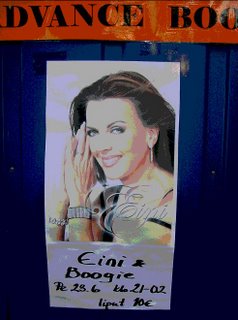 The main attraction of the festival's opening night was the performer "Eini" of the group Eini and Boogie. They performed what appears to be a very convetional musical mixture for Finnish dance halls of the last 30 to 40 years or so. This includes Finnish "folk" dances, or Finnish versions of other European folk or popular dances, including the yenkka and humppa (both a bit like the polka), the polkka, the waltz, and the mazurkka (this last was not performed on this particular night); the distinctive Finnish tango, a local adaptation of the Argentine tango, idiosyncratic in both music and dance style; and a variety of North American and Latin American popular dances: fox trot, rock, swing, rumba, chachacha, salsa, and samba. Following are scenes from the dance, and finally, an image of the low-sitting, never-setting, midnight sun.
The main attraction of the festival's opening night was the performer "Eini" of the group Eini and Boogie. They performed what appears to be a very convetional musical mixture for Finnish dance halls of the last 30 to 40 years or so. This includes Finnish "folk" dances, or Finnish versions of other European folk or popular dances, including the yenkka and humppa (both a bit like the polka), the polkka, the waltz, and the mazurkka (this last was not performed on this particular night); the distinctive Finnish tango, a local adaptation of the Argentine tango, idiosyncratic in both music and dance style; and a variety of North American and Latin American popular dances: fox trot, rock, swing, rumba, chachacha, salsa, and samba. Following are scenes from the dance, and finally, an image of the low-sitting, never-setting, midnight sun.
